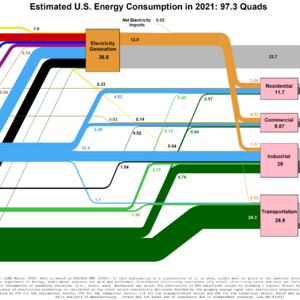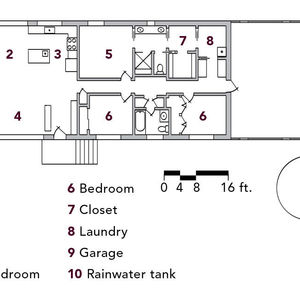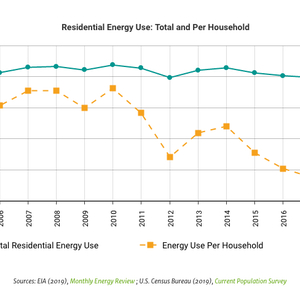
By Michael Horowitz
Home buyers expect green scoring systems to provide guidance when choosing between green-labeled homes. These expectations are largely unfounded, however, since almost every rating system ignores or inadequately considers a major determinant of a home’s environmental impact — its size.
Unchecked gluttony
Unlike other species, humans regularly use far more resources than necessary for survival. Our consumption rates are governed by fashion and personal economics, not anything resembling natural instincts. We consume at rates that nature is unable to accommodate. Our choices make us responsible for outcomes we personally abhor: species extinction, mercury contamination, strip mining, and melting polar ice caps.
We act as if the limits of nature are an inconvenience rather than an absolute. We pretend nature is confined within the human experience, rather than the opposite.
We naively believe that our environmental problems will be solved by technology, without any need for us to adjust our behavior. We continue to buy like there is no tomorrow, hoping others will develop green, energy-efficient materials for us. Forget “reduce, reuse, and recycle”: in our sacrosanct pursuit of happiness, we will just buy our way green.
This gluttony has led some to build ridiculously large homes. If they contain recycled materials, wood-pellet boilers, triple-glazed windows, and low-flow fixtures, we call them “green.” Never mind that these homes use three or five times the resources of an average-sized home — or more.
Unhelpful scores
These McMansions are only “green” because rating programs don’t properly question their size or occupant-to-space ratios. While some programs do provide credit for smaller homes, few programs credibly and equitably penalize excessive size. To my knowledge, only the Vermont Builds Greener program has a size limit.
Like the term “natural,” green is so loosely defined that it has become a favorite marketing buzzword. The ecological term “sustainable,” on the other hand, denotes a very bright line. A practice is either sustainable or it isn’t. Excess and luxury are not sustainable, and are certainly not traits we should ever tint green.
Many building materials and most sources of energy are nonrenewable, and all homes damage the environment when built and operated. When homes are eventually demolished, these materials are usually down-cycled rather than truly recycled. Big empty homes need to be furnished and maintained.
Most people expect green rating systems to quantify this damage. Homes with high scores should do less damage to the environment than homes with lower scores. While a green home should gain points for relatively benign materials, durability, energy efficiency, and healthier indoor air, it should also be reasonably sized.
The ballooning American home
In 1950 the average household had 3.37 members and the average new home measured 1,000 square feet. By 2000, average household size had dropped to 2.62 while the average new home had ballooned to 2,200 square feet. In fifty years, the ratio of square feet per person nearly tripled, growing from 297 to 840.
There is no biological reason to justify this huge increase in living space. No other animals build shelters with so much useless, wasteful space.
As Sarah Susanka points out so eloquently in her best-selling “Not So Big” series of books, building an unusually large home is a choice, not a necessity. Larger homes use more materials and energy, increasing each occupant’s ecological footprint. Even those who use greener materials and aim for energy efficiency have to admit that the least damaging home (or portion thereof) is the one that doesn’t get built at all.
There is little basis for the claim that it is better to have a large house built with green materials than a small conventionally built home. Energy modeling shows that a 1,500-square-foot home with poor insulation can still use less energy than a house twice its size with good insulation.
Greener materials and improved energy efficiency may lessen the impact of a large home, but those same measures also lessen the impact of an already-low-impact smaller home. However, it is the impact of the occupants, not the house, that really matters. Since small homes recognize nature’s limits by using use fewer resources per occupant, they help us approach sustainability — the real green goal.
Remember, green home program administrators: homes add to our ecological footprint. Small is green; big is not.
Weekly Newsletter
Get building science and energy efficiency advice, plus special offers, in your inbox.














3 Comments
Market Forces Rule, and Should Rule
This debate is really simpler than it seems. Dollars are the units with which we can measure and compare everything in a home’s cost. The home uses more land? That equals more dollars in purchase price, property tax, storm runoff fees, etc. It uses more resources to build because it’s bigger? Well, it costs more. The only thing that can improve the accuracy of dollars is a carbon tax that is allocated and implemented perfectly. I realize that won’t be easy.
Recurring costs are a little more difficult. That’s why the EPA created a standard MPG rating for cars, and the Energy Guide rating for major appliances. With them, people could compare their future costs of operation of their purchase against the other competitive products.
I submit that the only worthwhile rating system for homes will be in dollars per year. An accurate HERS score can be converted to $/yr with a standard set of conditions.
Another significant metric for a house is the cost of transportation incurred by the residents. Walk scores and other ratings can be standardized and converted to $/yr, and reported on the MLS. This is already starting to happen.
Now, with a purchase price and a $/yr rating in hand, the consumer will be motivated to buy small, because it’s cheaper. If they can still afford a 3,000sq.ft. house, they should be able to buy it, there is no reason to put an artificial cap on size. Markets forces work well if the consumer is educated.
Unfortunately, LEED scores and Energy Star ratings are a confusing mess: http://greenbuildingindenver.blogspot.com/2010/10/leed-for-homes-rating-system.html
mac mansions
Michael, your article reflects precisely the point I've been pressing on my colleagues and our developer clients for the last few years... unfortunately largely on deaf ears. Thanks for the article.
Carlos
money rules
I cannot disagree with the previous commenter more. Dollars are not a good measure. The market is not pure, subsidization and misinformation in marketing do not allow dollars to be the universal coin to truly find the value of anything, and money cannot define future value or costs. What was the last viable pair of dodos worth? What is the value of an ecosystem?
The history of ridiculously large American homes clearly comes from an Aristocratic history of privilege mingled with the Declaration's mentioned pursuit of happiness bastardized to mean the pursuit of any wasteful luxury we deem worthy. This is not my declaration of socialism but my insistence that this gluttony, while allowed (or even encouraged) in our society is not GREEN by any measure. The humble acceptance of "enough" is the basis of the term sustainability and part of its definition: to use resources today in a responsible way that does not inhibit the ability of future generations (or species) to use those same resources to meet their needs. I missed the pursuit of happiness mentioned in that definition. Do not confuse that "guaranteed pursuit" with a guarantee that anything you do can be spun to look green. It cannot.
This argument is not a matter of dollars, it is a matter of clear definitions and reason..
Log in or create an account to post a comment.
Sign up Log in